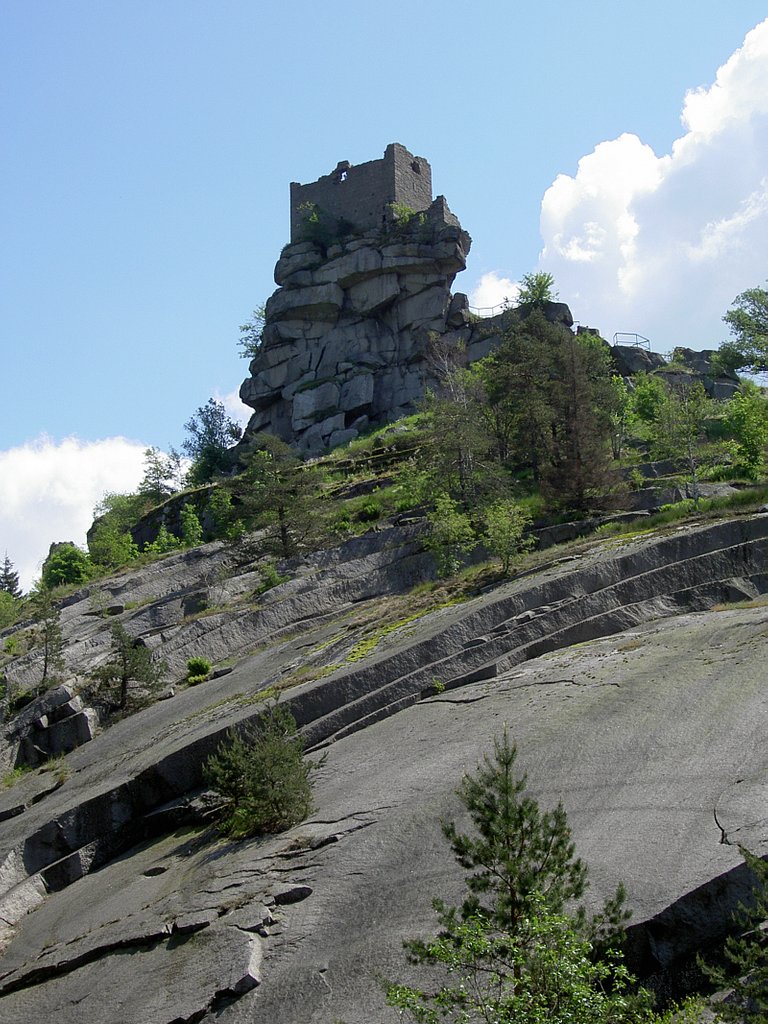Radon
Radon (Rn) is a radioactive noble gas. It is created in the decay chains of Uranium and Thorium. All of its isotopes are radioactive, and has semistable decay products that emit alpha particles when decaying. Due to its high density, it likely accumulates in buildungs, preferably in basements. The natural concentration depends a lot on where one lives. It can be particularly be high in regions with granite bedrock, due to the fact that granite contains a high level of Uranium and Thorium.

Granite rock. Walter J. Pilsak, CC BY-SA 3.0, https://commons.wikimedia.org/w/index.php?curid=23196906
Switzerland has created a radon map with a resolution of 1km x 1km:

Radon map of Switzerland. The colors denote the probability that the reference limit of 300Bq/m3 is exceeded.
Source: Federal Office of Public Health, https://www.bag.admin.ch/bag/en/home/gesund-leben/umwelt-und-gesundheit/strahlung-radioaktivitaet-schall/radon/radongebiete-ch.html
For an interactive version click here: https://map.geo.admin.ch/?layers=ch.bag.radonkarte&lang=de&topic=ech&bgLayer=ch.swisstopo.pixelkarte-farbe&layers_opacity=0.75
Effects on Health
The emitted alpha particles of the Radon decay products have a negative influence on human health. A study was performed in 2008 in Germany and Switzerland (Menzler S. et al, 2008, Health Physics: August 2008 - Volume 95 - Issue 2 - p 179-189 doi: 10.1097/01.HP.0000309769.55126.03). It was found that the average number of decays is 49Bq/m3 and 78Bq/3 for Germany and Switzerland, respectively. This leads to 5% and 8.3% of all cases of lung cancer for the two countries, respectively. Radon is thus the second highest cause for lung cancer after smoking and before asbestos.
Radon cannot be smelled or tasted or felt, so people are not aware of increased radon levels in their homes. Switzerland requires thus to monitor the radon levels regularly such that the legal limit of 300 Bq/m3 of air is not exceeded. There are several laboratories that are certified to measure radon concentration in buildings. In case the averaged radon concentration exceeds the legal limit, the house owners are required to take measures against the high radon levels.
Radon Monitoring and the Internet of Things
Now let's assume that a home owner installs one of these devices in a building. Let's assume that the device can publish its data once per day (or more often) to the internet of things (IOT). Now if the federal office of public health wants to check if the radon level in a building exceeds the legal limit, it subscribes to the data stream. Now not everybody wants to publish their data to the public, so the data must be masked (encrypted) with a key, that belongs to the house owner, and has to be requested from him or her by the interested data consumer. Furthermore, it should also be possible to sell this data, as it has a certain value.
If there was such a solution, there would be no need for certified laboratories that measure Radon concentrations, but there would be a need for certified sensors and a way to publish, mask and sell sensor data.
Furthermore, maybe there is more usage for the same data! There is some hints that Radon levels can be used as a predictor for earthquakes. However, the current evidence for a correlation between Radon and earthquakes is not significant. If, however, the Radon level can be accessed in a fine grid by scientists after an earthquake, they will have much more data to find correlations.Now this is all very static. Counteracting high radon concentration in a living room is actually quite simple, just open two windows and let the wind blow out the gas. The problem is that radon cannot be smelled, so we need a real time detector to measure radon concentrations. Luckily, measuring Radon is not that difficult. For example, the company Airthings develops affordable radon meters running on battery that can be installed in your home: https://airthings.com/ . As it is 2019 and Airthings is a modern company, several of their devices (e.g. the Wave) come with bluetooth, and an app for iphone and android. Additionally, it has a nice feature, when waving the hand above the device, it turns green or red, depending if the radon level exceeds a certain amount.
Radon Monitoring, Internet Of Things and IOTA
Luckily, the foundations of such a IOT data exchange, where data can be published and sold by data producers, and subscribed to and bought by data consumers exists already. It is called IOTA, and is a decentralized ledger, at least in its final form. IOTA is designed to be a foundation for the machine to machine economy, and perfectly suited to publish IOT data. IOTA is still under heavy development. We will use the current version of the masked authenticated messaging (MAM), which allows one to published encrypted. Up to now, there is no data marketplace, so the data cannot be sold yet. However, this is planned in the near future.
Send Radon Levels from an Airthings Wave to the IOTA Tangle
Set up your Raspberry Pi the same way. You will need to install the bluetooth dependencies on your Raspberry Pi:Now we come to the practical part. I will use the same infrastructure that I already described in an older blog: https://steemit.com/iota/@mragic/how-to-send-sensor-data-from-python-to-iota-tangle-with-mam
source /home/pi/venv/mqtt-to-iota
pip install bluepy
Then switch on bluetooth with:
pi@raspberrypi:~$ sudo bluetoothctl
[bluetooth]# power on
[bluetooth]# show
[bluetooth]# exit
Now you will need the MAC address of your Wave. You can find it with the python script from the airthings blog, and run find_wave.py as super user:
wget airthings.com/tech/find_wave.py
sudo find_wave.py
The repository (https://github.com/magictimelapse/mqtt-iota) contains a python script publish_radon_data.py. Open it and change the MAC address. Run in one terminal the script mqtt_to_mam_tangle.js
node mqtt_to_mam_tangle.js
and in a different terminal the radon data publisher:
python publish_radon_data.py
With a mam_receiver.js script (for example from here: https://steemit.com/iota/@mragic/how-to-send-ruuvitag-sensor-data-to-the-iota-tangle-with-mam-using-a-raspberry-pi-3), you can check if your radon sensor data goes through the IOTA tangle!
Congratulations @mragic! You received a personal award!
You can view your badges on your Steem Board and compare to others on the Steem Ranking